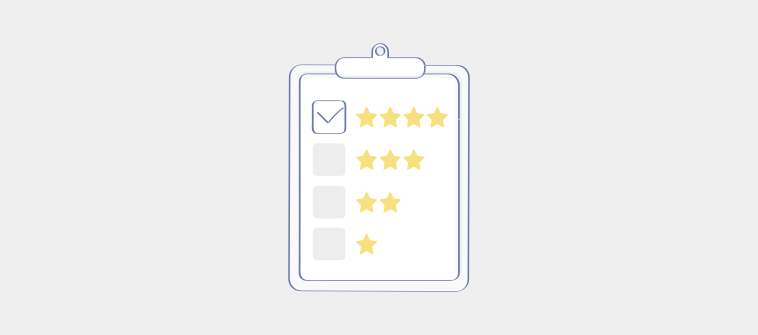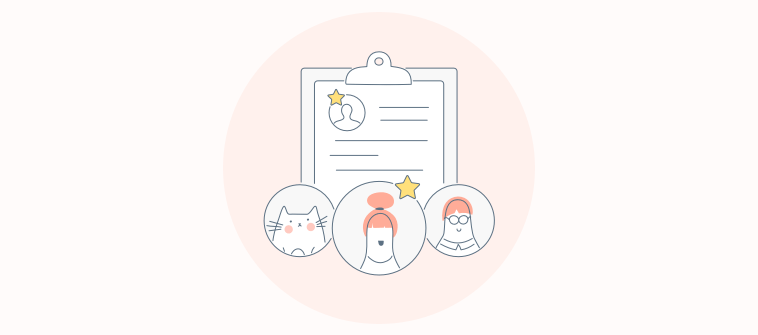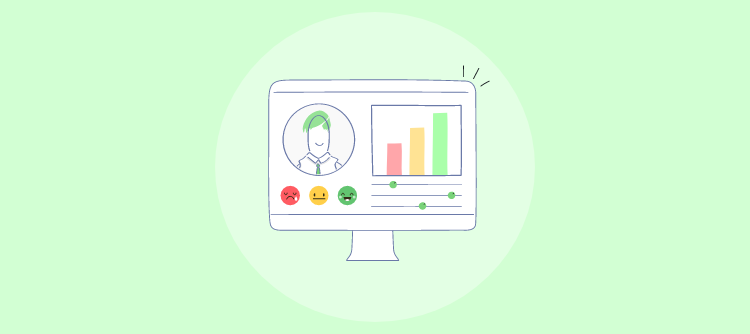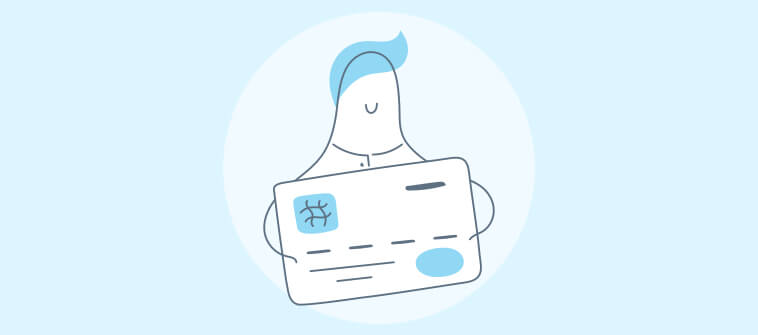
Are you happy with our product?
How likely will you recommend our product to your family or friend?
Where can we improve?
These customer survey questions are a great way to check your customer’s happiness with your products and services.
Good customer survey questions capture the real emotions of the customers that reflect the perception of the brand. The more engaging your questions, the better your customers’ response; the happier your customers, the stronger their chance of returning and buying further.
But, research shows that as few as 2% of your customers care to answer the survey questions.
Wondering why?
The reasons are manifold:
- Confusing questions
- Too much time to frame the answers
- Unclear answer options
- Lack of flexibility
- Unclear context and purpose
Don’t worry! Through this blog, let’s learn to write effective survey questions and win more customers!
Dive in!
Every Question Matters
Different survey questions intend to capture varied, unique inputs from the customers. Some questions require a straightforward answer from the customer while others dig deep into their emotions and perceptions regarding the product.
A good survey should have a balanced mix of questions to gauge the right sentiment of the customer. Different survey questions show you how to collect customer feedback the right way.
For example,
‘How would you rate our product on a scale of 1-5?’ is a close-ended question. The customer expresses his satisfaction or dissatisfaction with your product by choosing a numerical value on the rating scale. It is simple, straightforward, and easy to analyze.
In contrast, questions like ‘Any other recommendation?’ is an open-ended question. There is no definite answer to this question. The customer either chooses to be critical or gives positive feedback.
Come! Let’s learn more by jumping into customer survey questions examples.
Types of Survey Questions
Customer survey questions are broadly classified into Close-ended questions and Open-Ended questions.
1. Close-Ended Questions
Majority of the customer survey questions fall in this category. Herein, the customer chooses from a predefined set of answers. Often, customers are comfortable answering close-ended questions, thereby ensuring a higher survey response rate.
Close ended questions are further classified as:
- Multiple Choice Questions
- Level Rating
- Likert Scale
- Ranking
- Demographic Survey Questions
1. Multiple Choice Questions (MCQs): It is the most common type of customer survey question. Herein, the customer chooses between various options while filling out the survey. It requires less effort as the answers are predefined and straightforward.
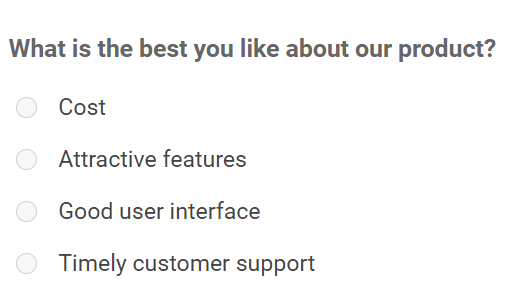
- Polar questions: A special case of MCQ that requires a simple ‘Yes’ or ‘No’ answer. It is comfortable for the customer to answer.
2. Level Rating: In this case, the customer uses a numerical scale to express his satisfaction with a product or a service. The scale rating is anywhere from 1-5 or 1-10.
A Net Promoter Score Survey is the best example of a level rating survey, as shown below. It gauges the customer sentiments on a level of 0-10.
Hence, the survey gives a detailed analysis of your audience:
- (0-6) score shows the number of detractors, i.e., customers unhappy with your product or service.
- (7-8) score brings forth the number of passives, i.e., customers with a neutral view of your product or service.
- (9-10) rating identifies the promoters, i.e., customers happy with your product or service.

Read More: What is a Good Net Promoter Score
3. Likert Scale: Likert scale captures the emotions of the customers ranging from their agreeability to non-agreeability.
For example, the scale has options like ‘strongly disagree’ to ‘strongly agree’, thereby capturing a comprehensive opinion.
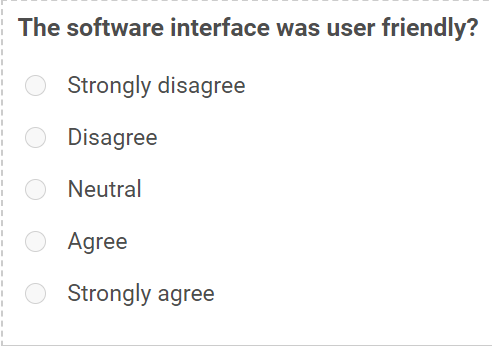
Read More: Checkout 20 Best NPS Survey Software
4. Ranking: Herein, the customers compare your company’s different products or services and rank them on the level of preference.
For example, a rank of ‘1’ means most preferred, and a rank of ‘6’ means least preferred. The information is useful to prioritize your product/service based on market demand. Further, you can reduce business costs by eliminating non-performing products.
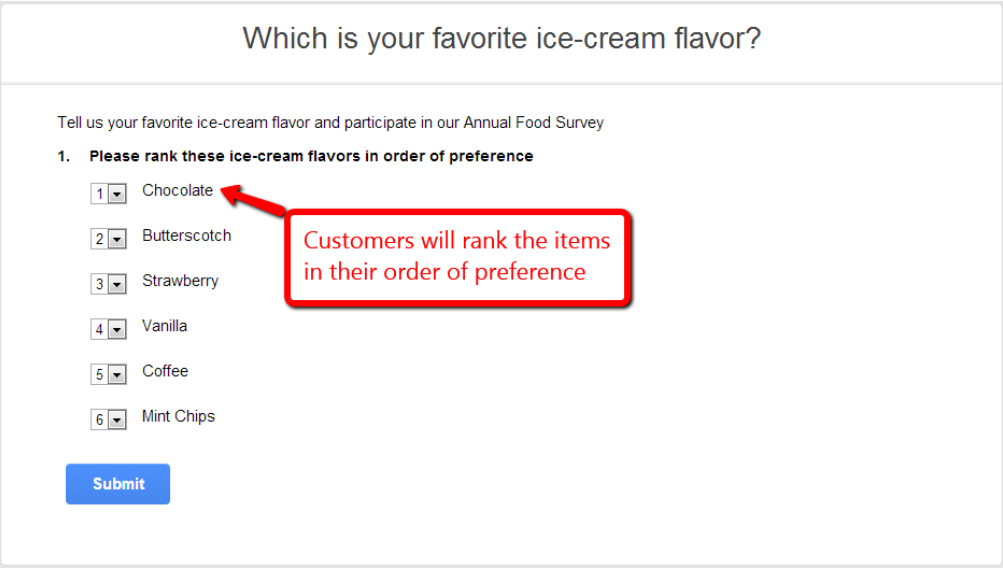
5. Demographic Survey Questions: These questions collect the personal information of the customers like age, gender, educational status, etc thereby helping you to know their preferences. Also, you can build a customer persona for building a focused marketing campaign.
2. Open-Ended Questions
Open-ended questions have no answer options for the customer to choose from. It requires deep thinking to answer and is time consuming. This format is best suited to take any generic feedback from your customer or customer suggestions that may have not been covered in the close-ended questions.
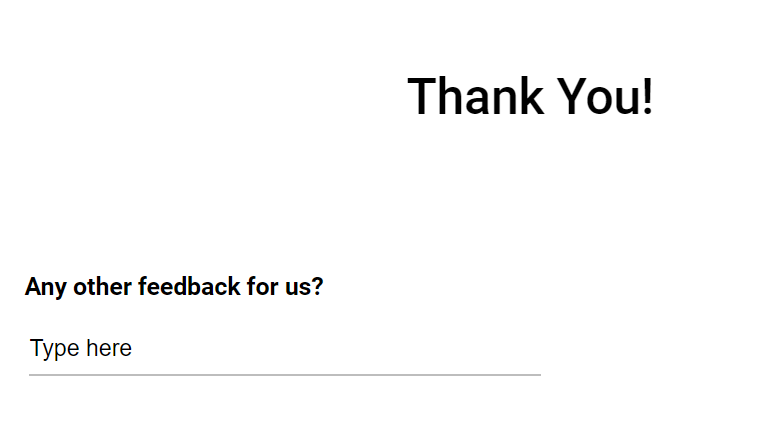 After a thorough understanding of types of survey questions, let’s learn the practical tips on how to write good customer survey questions.
After a thorough understanding of types of survey questions, let’s learn the practical tips on how to write good customer survey questions.
7 Tips for Writing Highly Engaging Survey Questions
1. Use a Clear and Lucid Language:
Imagine someone speaking to you about a product using jargon and you hardly understand it? Will you be engaged in the conversation, or confused? This is exactly what happens in a customer survey filled with jargon. Your customers leave midway, usually because they couldn’t connect well with your purpose.
Make sure that through the customer survey, you engage your customers in a conversation.
Make it worth their time.
- Use simple and understandable language.
- Refrain from using product or service technicalities, jargon, or abbreviations that the users do not understand.
Example:
“What do you think of our CST?” (Jargon used: CST for Customer Support Team)
“What do you think of our Customer Support?” (Correct Usage, Jargon avoided)
2. Adopt a Neutral Tone:
Don’t you want your customers to be honest and genuine in their feedback? You certainly do! Adopt a sincere approach while forming the questions:
- Do not try to misguide or influence their opinion in any way.
- Avoid confusing questions to get a favorable response.
Example
“We have a world-class customer support team. How do you rate this good feature?”
Herein, you state the fact that you possess excellent customer service. You have already created an opinion in the mind of the customer. Now, you are asking the customer to rate the same outstanding feature. In other words, you ask for a favorable response.
Never make this mistake. Give them an option of sharing their true opinion about your service.
Let’s rephrase the above question,
“How would you rate our customer support?”
The neutral approach adopted in the question above ensures a genuine and constructive response. It values the surveyees’ opinion and motivates them to complete the survey.
3. Offer Balanced Options in MCQs
If you ask your customer to pick from extreme options, you are not likely to get an honest feedback/opinion.
Customers have subjective and varied opinions based on their experiences. Some might be fully satisfied with your product, while others may be partially happy, and there could be a bunch of slightly disappointed customers.
If the right questions are asked with appropriate options, you can turn the slightly disappointed or slightly happy customers into your loyal army:
- Make sure you capture the full range of emotions in your survey.
- Do not restrict them to pick extreme end options: ‘like’ or ‘dislike’ the product.
Example
“How was your experience using our product?” (Incorrect way, restricted and biased options)
- Excellent
- Great
- Good
“How was your experience using our product?” (Correct way, wide and unbiased options)
- Excellent
- Good
- Average
- Needs improvement
- Poor
- Extremely poor
Giving them freedom of opinion with flexibility enhances the survey engagement.
4. Structure Majority of Your Questions as ‘Optional’ to Answer
Your customers may be unaware of all the answers to your questions. Pushing them to answer every question can jeopardize the entire survey process with unreliable results. There could be a random selection of answers or partially right answers.
- Keep the majority of your questions optional. It ensures the active participation of your customer in the survey from the beginning.
- You may keep 1-2 mandatory questions towards the end. Nevertheless, keep it brief and to the point.
Checklist of optional and mandatory questions:
| Mandatory Questions | Optional Questions |
|---|---|
| Short questions like – What is your name/contact/email? | Long questions, multiple-choice, rating, opinion scale |
5. Give More Weightage to Close-Ended Questions:
As discussed above, open-ended questions require more time and effort to answer. While close-ended questions are straightforward and easy to understand.
Make sure that you have maximum close-ended questions at the beginning of the survey. It acts as a hook and prevents your customer from dropping off. Since it doesn’t require too much thinking, the customers enjoy taking the survey and giving genuine feedback.
Keep open-ended questions to the end and limit them to two questions. Ensure they are not lengthy; it might prevent the customer from completing the survey.
6. Eliminate Loaded Questions:
A loaded question is a controversial question that does not have a straightforward answer. Loaded questions leave the customers perplexed, and abandon the survey midway through.
For example, for the question “Do you like tea or coffee?”, a person can have an unclear answer as “I like none”.
Remedy?
Modified Question: “What is your favorite drink?” (The question is straightforward)
Straightforward Answer: tea, coffee, milk shake, mojito etc. (Easy for the customer to give a clear answer)
7. Test the Survey with Peers:
Learned how to write good customer survey questions?
The last and crucial step in writing the right customer survey questions is to seek opinion. Share it with your friends, colleagues and family members. A new perspective on the questions is a prerequisite to gauge the depth and clarity of your questions. A sample testing of the survey will help you understand the shortcomings.
Evaluate your survey on the following parameters:
- What is the survey response rate? ( No: of people who took the survey/ No: of people who received the survey mail )
- Identify people who abandoned the survey midway. Learn the challenges faced by them to fix the issues that could hamper customer experience.
Read More: 250+ Survey Question Examples For Your Feedback Forms
Way ahead? Win more customers with actionable customer survey questions
Writing good survey questions can prove to be a competitive edge for your business. Knowing the customer’s concerns at an early stage helps you to address their queries effectively. Try a balanced mix of closed and open-ended questions to make your customer survey holistic and inclusive.
Remember, your customer is the king and giving them what they desire can lead to business growth!
What’s next? Create a survey using online questionnaire software like ProProfs Survey Maker.
We here at ProProfs have readymade, customizable surveys. Save your time by choosing from 100+ templates within minutes. Hear the real heart-beat of your customer!
FREE. All Features. FOREVER!
Try our Forever FREE account with all premium features!

 We'd love your feedback!
We'd love your feedback!
 Thanks for your feedback!
Thanks for your feedback!


